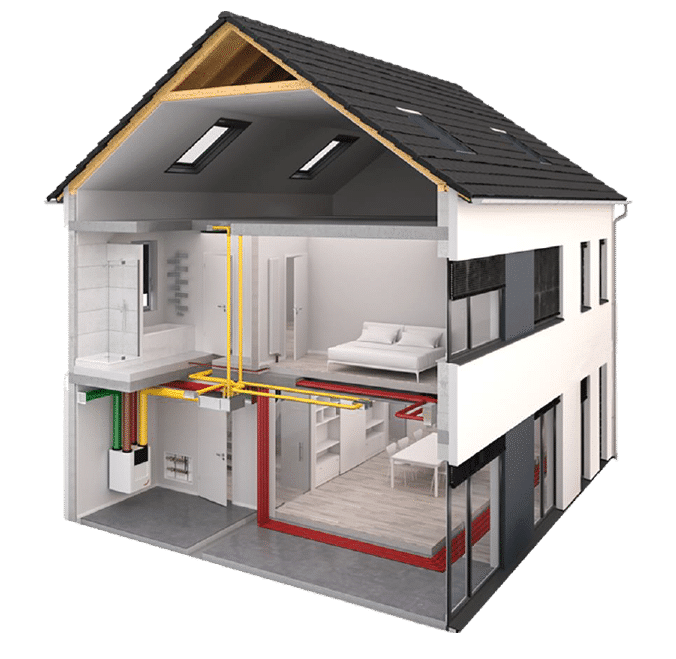Why Invest in HRV? An Honest Look
Wiki Article
Checking out the Conveniences of Heat Recovery Ventilation for Power Efficiency in Houses
Heat Recovery Ventilation (HRV) systems provide homeowners a useful technique to enhancing power performance. By redeeming heat from outward bound air, these systems can considerably reduce home heating and air conditioning costs. In addition, they offer a constant supply of fresh air, boosting indoor air top quality and comfort degrees. As property owners take into consideration lasting options, comprehending the subtleties of HRV systems comes to be increasingly essential. What aspects should one review prior to making such an investment?Comprehending Heat Recovery Ventilation Solutions

Exactly How HRV Boosts Indoor Air High Quality

Power Financial Savings: The Economic Advantages of HRV
Taking full advantage of energy efficiency, heat recovery ventilation (HRV) systems offer considerable financial advantages for home owners. By recouping and recycling warm from exhaust air, HRVs substantially reduce heating and air conditioning prices. This modern technology can bring about power financial savings of approximately 30%, depending upon environment and usage patterns. Homeowners commonly see decreased energy costs quickly after installment, making HRVs an economically smart investment with time. Furthermore, numerous areas supply incentives or discounts for energy-efficient upgrades, additionally enhancing the economic charm. As energy costs remain to climb, the cost-effectiveness of HRVs ends up being increasingly clear. On the whole, the consolidation of HRV systems not only advertises energy performance yet likewise adds to long-lasting financial cost savings for families.The Environmental Impact of Heat Recovery Ventilation
A significant ecological advantage of heat recovery ventilation (HRV) systems hinges on their capability to reduce general power consumption. By recovering warm from exhaust air and moving it to incoming fresh air, HRV systems decrease the requirement for energy-intensive home heating and cooling techniques. This reduction in energy demand adds to decrease greenhouse gas emissions, as less fossil gas is required to preserve comfortable interior temperature levels. Furthermore, HRV systems improve indoor air quality by effectively trading stale air with fresh outdoor air, minimizing dependence on mechanical cooling systems that can damage the environment. In general, the implementation of HRV systems supports sustainable living techniques and lines up with international initiatives to combat environment change by promoting energy efficiency in residential setups.
Choosing the Right HRV System for Your Home
Just how can property owners assure they select the right heat recovery ventilation (HRV) system for their demands? They must evaluate their home's size and layout, as these aspects influence air movement demands. Next, reviewing the system's effectiveness ratings is essential, as higher rankings suggest better efficiency and energy financial savings. Homeowners need to likewise take into consideration setup and maintenance prices, comparing different brand names and versions for worth. Additionally, it is very important to examine noise levels, as some systems run more silently than others. Consulting with HVAC specialists can supply customized recommendations based on certain home problems. Checking out customer evaluations and service warranties can help in making an informed choice, guaranteeing that the selected HRV system properly enhances interior air high quality and power effectiveness.Frequently Asked Concerns

Exactly how Often Should I Tidy or Keep My HRV System?
The regularity of cleansing or preserving a warmth healing ventilation (HRV) system commonly depends upon use and environmental factors. Typically, it is advisable to carry out upkeep every 6 months to guarantee peak efficiency and air top quality.
Can HRV Solutions Help In Reducing Moisture Levels Inside Your Home?
HRV systems can properly reduce indoor moisture degrees by trading stale, humid air with fresh, drier air from outdoors. HRV Heat Recovery Ventilation. This procedure assists preserve a well balanced interior environment, boosting comfort and HRV Heat Recovery Ventilation protecting against moisture-related problems
What Is the Life-span of a Typical HRV System?
The lifespan of a common heat recovery ventilation (HRV) system varies, normally lasting between 10 to 15 years. Regular upkeep can expand its effectiveness and operational life, making certain peak performance throughout its use period.Are There Any Type Of Noise Worry About HRV Equipments?
Noise interest in HRV systems can develop, particularly from fan operation. Many contemporary units are designed to decrease sound levels, ensuring they run silently while preserving efficiency, which resolves possible disruptions in living atmospheres.Can I Install an HRV System Myself, or Do I Need a Professional?
The specific contemplated whether to set up the heat recovery ventilation (HRV) system personally or hire a professional. Typically, while do it yourself installment is feasible, knowledge assurances appropriate performance and conformity with regional building codes, enhancing system effectiveness.Report this wiki page